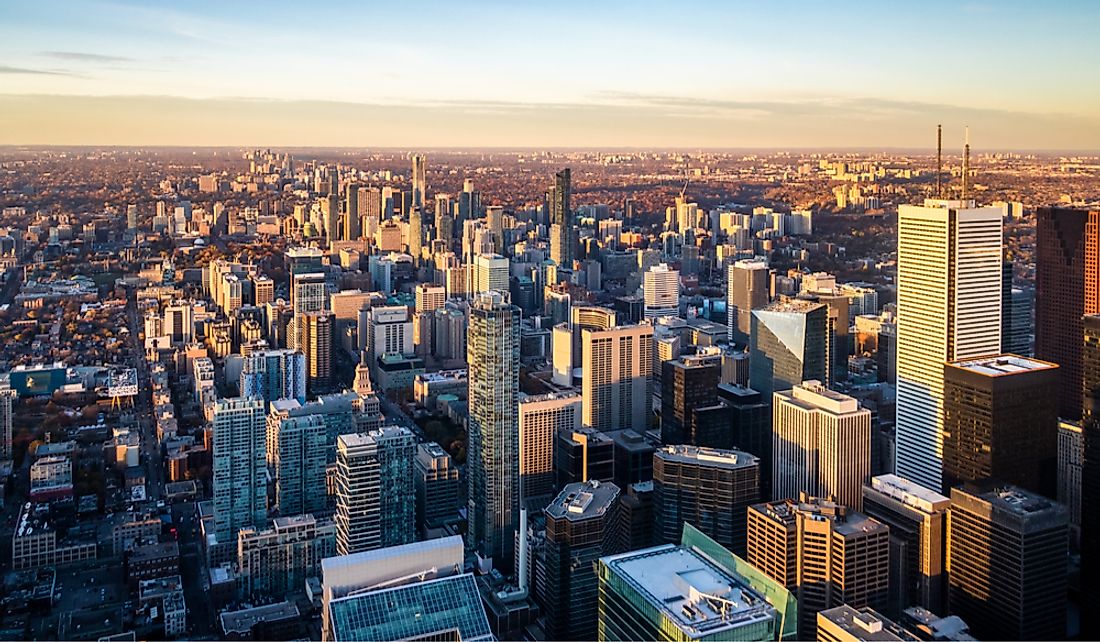Canadian Provinces and Territories By Population

Canada is the second largest country in the world after Russia but ranks 38th in population with about 37.3 million people. It is a large country that extends from the Atlantic to the Pacific and north to the Arctic. The entire southern boundary is shared with the United States. Canada conducts a population census every five years. The 2016 census estimated the population at 35 million representing a 4.9% increase from 2011.
The Most Populous Canadian Provinces
Ontario
Ontario is the most populous province in Canada with 14.45 million people representing 38.3% of the country’s population. It is home to the country's most populous city, Toronto, and the capital city, Ottawa. The province covers about 415,598 sq mi and has a population density of 37.9/sq mi.
Quebec
Quebec has a population of 8.4 million people, making it the second most populous after Ontario. It is the only predominantly French-speaking province, and the French language is recognized as the official language. Most people live in urban environments with half the population residing within the Greater Montreal area.
British Columbia
Approximately five million people inhabit the province of British Columbia. Half of the province population lives in Metro Vancouver and the Greater Victoria area. Eight of 100 fastest growing neighborhoods in Canada are in British Columbia. The population density of the province is 13 /sq mi, but the southern region that borders the United States is densely populated compared to the northern areas.
Alberta
Alberta is the fourth most populous province with a population of about 4.35 million as of 2019 up from 3.7 million in 2011. It is also the most populous of the prairie provinces of Canada. Approximately 81% of the population lives in urban settlements, while 19% are in rural environments.
Population Density
Canada’s population density is highly skewed. About 80% of the population lives within 100 miles of the border with the United States. The four largest divisions (Nunavut, Quebec, Northwest Territories, and Ontario) cover 61% of the country while the four most populous (Ontario, Quebec, British Columbia, and Alberta) account for 86% of the population. Yukon, Nunavut and Northwest Territories cover a third of the country but are inhabited by only 0.3 percent of the population.
Indigenous Population
Canada is a multiethnic nation. There are about 1.7 million indigenous people in Canada. The indigenous community consists primarily of the First Nations, the Inuit and the Metis. Although most of the indigenous people have integrated with the rest of the country, some are still isolated in Indian reserves. There are no definitive accounts of the population of Canada before the arrival of Europeans, but more than half died from contagious diseases such as smallpox, measles, etc., introduced by the invading Europeans.
Population Growth and Immigration
Canada’s population tripled from 11 million in the 1940s to 37 million in 2018 and has been growing consistently over the past 50 years, registering a 4-5% population increase annually. The growth is fueled by immigration with the country receiving the 6th highest net immigration and attracting more immigrants per capita than the United States. In contrast, the natural population growth in the country accounts for 1/10 of the population increase.
Canadian Provinces and Territories By Population
| Rank | Province/Territory | Population |
|---|---|---|
| 1 | Ontario | 12,851,821 |
| 2 | Quebec | 8,164,361 |
| 3 | British Columbia | 4,648,055 |
| 4 | Alberta | 4,067,175 |
| 5 | Manitoba | 1,278,365 |
| 6 | Saskatchewan | 1,098,352 |
| 7 | Nova Scotia | 923,598 |
| 8 | New Brunswick | 747,101 |
| 9 | Newfoundland and Labrador | 519,716 |
| 10 | Prince Edward Island | 142,907 |
| 11 | Northwest Territories | 41,786 |
| 12 | Yukon | 35,874 |
| 13 | Nunavut | 35,944 |











